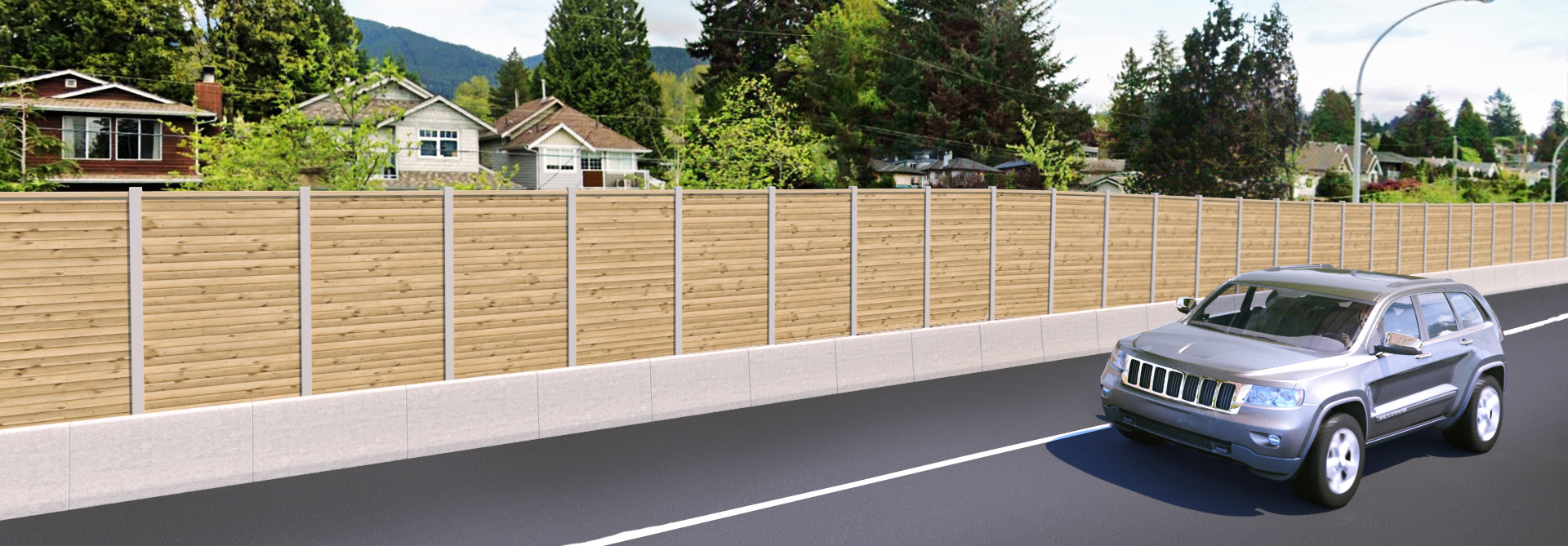New Research by FPInnovations Concludes that Pacific HemFir has Superior Noise Reduction Properties
As more and more housing developments start to fill in the gaps between rural and urban areas, greater solutions for sound shielding are needed. That’s because most of those untapped stretches of land often back up onto highways and busy roads. This puts the residents of those homes at risk of sleeping issues and a whole host of health issues related to prolonged exposures to noise pollution.
There’s also the very real and very pressing issue of sustainability. Currently, the building sector accounts for 30-40% of annual global greenhouse gas emissions. Ergo, erecting miles and miles of sound barriers with anything but natural building materials would be a giant step backwards in the fight against climate change. Where wood actually removes carbon from the atmosphere, steel and concrete emit it. In fact, from cradle to grave, wood harvested from sustainably managed forests is the greenest choice available for sound abatement.
So, it makes sense that until very recently, most engineers looking for sustainable solutions turned to Douglas Fir for sound abatement fencing systems. But we can do even better now. New independent studies prove that the superior species of sustainably harvested BC wood for sound barriers is in fact, not Douglas Fir. It’s Pacific HemFir, and as a recent report by FPInnovations points out, Pacific HemFir is “an underutilized species” that’s inherently ideal for customized noise-reduction products. Here’s why:
Longer Lasting Lifespan
When building exposed fencing systems that will have ground contact and zero coverage from the elements, the wood needs to be treated with an environmentally friendly preservative. This ensures less need for replacement over the years to come. Thanks to Pacific HemFir’s unique cellular structure, it accepts and holds finishes better. And not just any finishes but natural treatments specially formulated with the most sensitive habitats in mind.
Comparatively, other species don’t hold these preservatives as well, thereby decreasing the performance life of the wood. So, if Pacific HemFir lasts longer than other natural materials, why isn’t it being used more for sound abatement fencing?
“There’s a lot of misinformation or old information out there,” explains Jay Secord, Sales Manager at CanWel, sold under MicroPro Sienna, where he specializes in treated wood. “It’s important that everyone is educated with the most updated info, and the truth is Douglas Fir doesn’t accept preservatives as well as HemFir and the idea that Douglas Fir is stronger has also been proven inaccurate, in some instances.”

More Structurally Sound
In areas susceptible to seismic activity, you need a strong, structurally sound, durable wood that won’t bend and loosen fasteners. Again, Pacific HemFir is wood that works. It’s a technically superior wood that keeps nails and screws in place for greater stability and less need for replacement parts.
Furthermore, Pacific HemFir fencing products stay true with very little contracting and expanding in response to varying moisture content, which is especially important in humid climates.

Image courtesy of FPInnovations
Easier to Maintain
In communities where graffiti is on the rise, the Pacific HemFir SoundShield offers an economic solution. With a brush of paint, vandalism disappears. The Pacific HemFir SoundShield is built in panels so if there is damage, individual sections can be repaired or replaced without disturbing the rest of the barrier. Fencing systems made with manmade materials, on the other hand, require extensive and costly repairs because they are often one solid structure. So problem areas are harder to isolate.
The modular construct of the Pacific HemFir SoundShield, therefore keeps maintenance fees way down for both public and private developers.
Environmentally Friendlier
Woods such as Pacific HemFir sequester and store carbon through the entire lifespan of products. And the sun is the only energy source required during production. Pacific HemFir is also considerably lighter to transport and manufacture, which again results in the least amount of energy expenditure.
Unlike steel and cement, Pacific HemFir is 100% renewable. As well, Pacific HemFir is responsibly harvested to sustain and protect British Columbia’s forests and their ecosystems. A global leader in ecologically sustainable forestry, 200 million seedlings are planted annually.

Cost Effective Choice
Pacific HemFir is a combination of Western hemlock and Amabilis fir, two of the most iconic and plentiful coniferous species in BC. Nearly identical in every way, these two trees are harvested and manufactured together, providing an abundance of wood.
So from a cost perspective, this readily available hybrid species offers real value in the sound abatement world. You can get a premium, top-performing wood without the price tag of a limited luxury product.

Better Community Builder
A sound barrier should do more than protect residents from noise pollution. It should create a sense of community and connect residents to nature and each other. A prison-like cement wall cannot do this.
Pacific HemFir is an especially beautiful wood with straight, consistent grain and a light honey hue. Long revered for its architectural appeal and versatility, Pacific HemFir’s appearance makes for a visually pleasing sound barrier with the warm appeal of a neighbourhood fence. And really, isn’t that what residential development is all about -building better communities?
For more information on the benefits of Pacific HemFir’s sustainable, carbon neutral noise reduction system, read this brochure.
